From a New Yorker cartoon.
Picture two straw-chewing, cockeyed hobos perched on a wall.
Hobo 1 to hobo 2:“Crazy busy. You?”
How does a witness on oath in court give a sensible answer as to her location on a date say a year ago? It’s hard to remember last week, impossible to recall a day last month. An oblivion ago I blithely damned Melbourne for being boring and short of things to do, compared to … Berlin (where I’ve never been). Constant Gardener gave a derisive snort and suggested I had no idea. Well, Gardener was right; I was wrong. I clicked up the iCal to check the last four weeks for what crossed my path; nearly all these outings have been previously unMulched.
Couch time. July 25, 26. Monday, Tuesday ticks the clock.
Cat Poljski: City intervention project, 2011, Etching, digital print, 60x85cm
Art crawl. July 27. Gallery crawl with art buddy C_ who wanted to visit a show of Tully Moore paintings at John Buckley Gallery. Moore is an up and comer with a escalating gift for trompe l’oeil; the show impressed with at least a third displaying red dots (Moore’s work is not to my taste; but he surely has fans). As a Sydney painter said to C_ and me recently, ‘I read the papers and I think, why would anybody want to spend money on a painting nowadays?’ Also checked another four galleries along Albert St, Richmond. Sales are slow. Now that I’m tuned into printmaking because of ABR covers, I noted the print show at Jenny Port by Cat Poljski, which had rave reviews. And not a few sales to boot.
+ + +
Designer morning: July 28, State of Design Festival: skype interview at 8 am (!) with legendary designer Milton (I Heart NY) Glaser in New York. I’ve been a fan of Big Milt for decades and have made work in homage, so it was good to see him writ large on a screen as he talked to the back of the panel’s four heads on the stage. He said nothing surprising, but he said it with very well; he listened to questions and addressed them with seriousness and directly. No crap. His wore his authority like a cashmere cardigan. The Wheeler Centre was full — there must have been 250 people there at that uncivilised hour of a Thursday morning. (He looks angry on the screen here, but he wasn’t — he was calm and sage. As a New Yorker, one might say that he was the wisest guy in the room.)
One question on the minds of what seemed a youngish audience was about computers and design. Milton: I work with computers every day but I can’t turn one on. I sit next to these clever young people [who operate the computers] and we talk about what to do… We think computers are our slaves, but computers are very actively making us their slaves.
I have uploaded some Glaser sketches on the Wheeler Centre Sketchbook flickr. (Along with other drawings from this year which I’ve been neglectful of, including ones of Mem Fox, John Burmingham, Sonya Hartnett, Name Le, et al.)
+ + +
Randy with an orchestra. July 30. Randy Newman plays with the MSO. J1_ comes down from the country, we dine early at the Supper Inn and stroll down to the State Theatre. When Newman last played in Melbourne, over 20 years ago, it was just him and a grand piano at the Concert Hall; that easily rates in my top five favourite concerts. This time round he is also one of the most regarded movie soundtrack composers and his set is marked in the middle by MSO renditions of bits from four scores. Newman: “You have one of the best orchestras in the world, please keep supporting it.” (I confess, two extracts would have done for me. Here he is, about to conduct.)
Newman is blessed with jokes. The audience joined in, as directed, on the chorus of his rock star satire, I’m Dead (But I Don’t Know It): “You’re dead, you’re dead!” we shouted enthusiastically. At the finish Newman remarked, “I’m touched.” He explained his (dry, bleak) tune Sail Away as “a song about recruitment for the slave trade — the best song ever written on the subject.”
As it happens, his explanations really do illuminate — so now I know that In Germany Before the War, which I had always thought of as an unsettling bit of reverse nostalgia about pre-war states, turns out to be about a child molester, which really is in the lyrics. And that Short People is not about prejudice — it’s a comic song about a nut; an idiot who holds idiotic opinions: “Short people got no reason / To live …” which is a more subtle and perhaps more enduring idea. But then, characteristically unusual, a Randy Newman song has ideas, actual content. It’s a great concert, full of cheer without the beer, wit with a side of grit, self-awareness enriched by communal pleasure.
+ + +
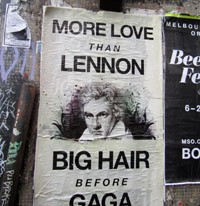 Rolled over. Aug 6-22. Speaking of the MSO, I sorta did want to do the Beethoven Festival; the cool advertising did the trick. But in the end my appetite and staying power for a cycle of long-form period concerts was weaker than my desire.
Rolled over. Aug 6-22. Speaking of the MSO, I sorta did want to do the Beethoven Festival; the cool advertising did the trick. But in the end my appetite and staying power for a cycle of long-form period concerts was weaker than my desire.
+ + +
Con, temporary art. July-August. All this month, in between required reading, I’ve been supping at Terry Smith’s What is Contemporary Art? Smith is an ex-pat who is a big noise in art theory circles (Prof. of Con. Art & Theory, Uni Pittsburgh). A friend of mine has just gone off to study with him, which is why I’m reading the book. I find it extremely stimulating and highly disagreeable — my copy is blackened with empathic marginalia (below). As a corrective I reread Peter Timms’ What is Wrong with Contemporary Art?, a book which was contemptuously attacked by critics (well, at least one or two) when it came out in 2004. It’s a bracing alternative to the art world anxiety of keeping up with the New. The New is not so much The Shock of, anymore; more The Weariness of the Novelty of. But I persist with Terry Smith.
+ + +
Author, author! August 1. Missed a lunch with author Kate Grenville who is getting ready for the publishing of her new novel, the last volume of the Secret River trilogy, Sarah Thornhill. (Kate reads a bit from it here.) My bad, it was mis- iCal-ed for the following Monday. Mobile rattles: Where are you? asks the publisher, keeping cool. As it happens, on a long walk through a park. I sent a sorry card. Oh dear, it’s the third time I’ve a forgotten to go to a breakfast/lunch this year.
Later that evening in Carlton for the book launch of Cargo by Jessica Au — whom I met when she was deputy editor of Meanjin. Her debut novel (you wouldn’t know it), Cargo is rather brilliant, telling the stories of three late teens in a small town on the coast. All the stuff that goes through a teen’s head is here, which is to say it goes through your heart too (a shocking reminder of youth’s intensity); all those first sensations, and I’m not only talking about infatuation or sex. The delicate revelation and understanding of these feelings takes it into adult territory, though any intelligent adolescent might enjoy this.
Now, as a book designer it behooves me to remark a curious thing about the cover. Surfing the Guardian, I was surprised that Picador were running an ad campaign for the book on the homepage — extraordinarily lavish! I thought. But no, it wasn’t for Cargo. The cover is on the left; on the right are four frames from the Guardian house ad. One also notes that the designer for Au’s cover lives and works in London. Coincidence?
+ + +
Video art. August 2. Met up with F_ to see our friend J2_ who is part of a show of video art at the Victoria University city campus. Very stylish — 24 shorts looping on 80s TV sets, the sound coming over colour coded telephone receivers plugged into the audio sockets. I don’t care much for video art — here the setup provides more charm than the contents. I do like our friend’s work in this case — it’s earlier work, sepia-ish, hand-made and spliced before digital technology; a formalist piece about some of the art possibilities of materiality. Ya, anyway, moving along…
+ + +
Contemporary Aboriginal. August 3. A drink at the offices with Rai Gaita whose new book, After Romulus, was launched by John Coetzee in Adelaide last week. Rai and his wife Yael are going to see Amos Oz give an address at the Town Hall. I had meant to go to that but instead am off to the opening of a show, Groundwork, at the Ian Potter Museum of Art at Melb. Uni. It is launched by Dr David Hansen who typically gave a glittering speech, freshly re-locating contemporary Aboriginal art today. The crowd was somewhat dazzled — it’s not the kind of thing, in style and quality, you get to hear much of at these functions. The pictures at the show are mostly very bloody good; they have a certainty and joy about them.
+ + +
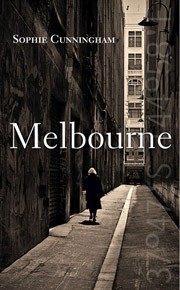 Slump. Aug 4. Was to go to an opening at the VCA, but piked to slump at home.
Slump. Aug 4. Was to go to an opening at the VCA, but piked to slump at home.
+ + +
Tout le Melbourne. August 5. Drinks with old friend and writer Sophie Cunningham at the Standard in Fitzroy to celebrate her little book of splendours, Melbourne. I find her in the middle of a large room packed with friends and well-wishers. Melbourne is also splendidly personal, and I joke that maybe it should have been titled Fitzroy. She laughed — there is some justice to my remark, but neither is it overly germaine. Her walking tour of Melbourne for the Writers Festival was booked out, like that. Here’s a story: conversation overheard in an inner city bookshop, re Melbourne: ‘Well, we’re in the book, and you’re not…’
+ + +
Aboriginal art class. August 6. Synchronistically, after the Hansen talk on Aboriginal art, I am at Alcaston Gallery this morning for the exhibition, Namatjira: Another Generation. More exactly, I’m here to learn how to paint like a descendant of Albert Namatjira. The work of the three artists here are amongst those on the walls — Kevin Namatjira; Hilary Wirri; Lenie Lankin; and an apprentice painter, Rosabell. I was startled when they walked in — not just that these four large, very dark-skinned folk, the blokes in plaid checks, looked out of place in a white cube gallery; but also that the grandson Kevin was a near spitting image of Albert. That’s him above, left; drawing the outline for his picture; and the painting at half time.
(Above: Lenie Lankin, Kevin Namatjira. More and larger drawings at the Culture Mulcher Sketchbook flickr.) It was an “observational” workshop — watching how the artists made their work and copying the moves. I followed Kevin as he made his picture. Looking down, zoning out the room, he pencilled outlines of a landscape without hesitation; he was drawing the scene in his head. Then he began to fill the sky and trees and land with sweeps of watercolour, methodically waiting for areas to dry before overlaying washes. Pure fascination. The pictures on the wall looked great, but I think that working in a workshop is the opposite situation necessary for making a masterpiece.
The other thing is that the three artists are part of Namatjira at the Malthouse, a play about the life of Albert, now touring Victoria after its sell out season in Sydney. I’d like to see them do their thing on stage.
+ + +
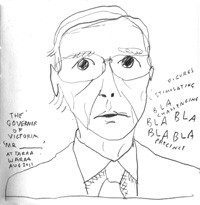 The Guv’ at Tarrawarra. August 7. I’ve already blogged this. Just one addition — His Excellency the Governor had quite an amount to say about the second show he opened: a Sandra Leveson survey. He orated with a — shall we say — surprising lucidity and detailed engagement about her abstract paintings. Call me sceptical or denialist, but I don’t think he wrote that bit himself.
The Guv’ at Tarrawarra. August 7. I’ve already blogged this. Just one addition — His Excellency the Governor had quite an amount to say about the second show he opened: a Sandra Leveson survey. He orated with a — shall we say — surprising lucidity and detailed engagement about her abstract paintings. Call me sceptical or denialist, but I don’t think he wrote that bit himself.
+ + +
Author, author, Harry Potter. August 8. Lunch with a friend — who happens to be an author — down from Sydney. M__ hasn’t come down for work or books or publishers. It’s a mission of mercy and she is quite upset. Good thing I remembered the appointment. In the evening I meet up with fellow yogist A__ to catch the latest and last Harry Potter in 3D. It’s rather fine and excitingly satisfying. David and Margaret both give it three and a half stars. You have to be a fan of at least the books to bother going in which case I think it fills the brief fully. But it was good too, to go off for dinner with A_ and her friend J3_ to argue over unmagical adult Muggle politics.
+ + +
Davila at MUMA. August 10. Juan Davila takes me for an artist’s tour of his show, The Moral Meaning of Wilderness, at the Monash University Museum of Art. It’s always great to hear articulate artists talk about their work, and even better to have a chance of asking questions. So I can say that the Wildnerness in the title is also symbolic of inner wilds, and — though it is not hard to read — that the three rooms segue from art about art and art theory, to landscape in plein air (and a microsopicscape), to end in a room of innervisions. The paintings are very Davila, fluent and unconcerned about the niceties of polish and finish; that is to say they have contemporary resonances. All are clearly, I mean recognisably, by him, even the final room of abstracts, a new move on Juan’s part — and it is very intriguing to be able to pick a figurative painter’s hand at work — consider, there are no “figures” to compare against one’s mental archives of the artist’s oeuvre.
Regarding one landscape — with an oblique title including the N word (nuclear) — that artistically, metaphorically, suggestively vapourises midway into thin air, I said, Juan did you stop to have lunch and never went back to finish it? He laughed while nodding vigorously. As the artist Sally Smart said to me at the opening a few days later (August 13), ‘Intentionality has nothing to do with it.‘
+ + +
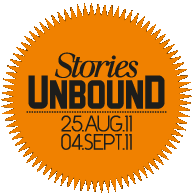 Designing a talk. August 12. Meet with super designers Sandy Cull, Jenny Grigg and Virginia Murdoch to map out our talk for the design session at the upcoming Melbourne Writers Festival. (Shouldn’t there be an apostrophe after Writers?) The session has been lumbered with the resistible title Irresistible Book Design. We have already decided to focus on the future, which is pretty much the same as our fast receding present. It’s not so much that, in book publishing, we feel like we’re on the edge of a cliff in danger of falling, but that the cliff is falling under us. At least we can justify the title — re the electronic future of book design, resistance is futile*. I think it’ll be good; or, we’re doing a lot of research and putting a lot of work into it, so at least it’ll be good for us. (Note to self: write script; make slides.)
Designing a talk. August 12. Meet with super designers Sandy Cull, Jenny Grigg and Virginia Murdoch to map out our talk for the design session at the upcoming Melbourne Writers Festival. (Shouldn’t there be an apostrophe after Writers?) The session has been lumbered with the resistible title Irresistible Book Design. We have already decided to focus on the future, which is pretty much the same as our fast receding present. It’s not so much that, in book publishing, we feel like we’re on the edge of a cliff in danger of falling, but that the cliff is falling under us. At least we can justify the title — re the electronic future of book design, resistance is futile*. I think it’ll be good; or, we’re doing a lot of research and putting a lot of work into it, so at least it’ll be good for us. (Note to self: write script; make slides.)
*wildcat: Pan Macmillan Australia has today announced the launch of a Digital-Only imprint, momentum. It will go live in February next year. One of the authors on the list, John Birmingham, is boyfan enthusiastic: ‘This is so cool, so inevitably going to be awesome, that if Pan hadn’t gone there, I was totally gonna go all wildcat and do it myself. It means writers can experiment in ways that just aren’t possible when you’re betting the mortgage on a book that took four years to write . . . ‘ I can’t quite see what he means by that last bit — doesn’t it still take as long to write a book, and more if you are exprerimenting? Unless, or course, you are not a digital-only author and still expect to get returns on traditional paper books.
+ + +
Groovers turn 40. August 13. Attend a friend’s 40th birthday bash — he’s already been going at it for 40 days. I’m ready for it to be over, confides his wife. This event starts at 9pm for drinks at a warehouse bar in the city. Thankfully it’s not as noisy as the last time, a few years back, though still too loud for conversation that’s not shouted. But they play back to back near classic disco — I could have danced to every track, and wished we were staying. But we move on to one of those private dance club/bars with no name or address, or directions; it’s in a dark alleyway. It’s been booked for the party and the volume just goes up by the minute. And whatever house mix/postcrunk/dubstep it is the two DJs are spinning, my feet winehouse with no no no. Why, I wonder, are these hipsters so badly dressed? But that’s as wrong a question as asking about aesthetics in contemporary art — it’s not about a judiciously gradable quality (“beauty/excellence”, wha’? shh! here come the Theory Police!), it’s about the frame we choose to share — it’s a consensual illusion, as William Gibson explained about cyberspace. In bed by 2, phew.
(Afternote: But N_, in case you are reading, i luv ya, and you‘re the party.)
+ + +
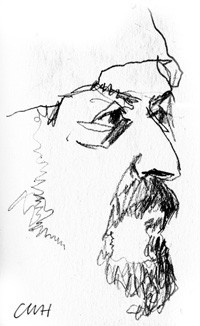 The Devil’s draughtsman. August 16. With art buddy C_, back to MUMA to hear another artist’s floor talk. It’s Jason Greig, from Lyttleton, Christchurch, whose main method is monoprint (here’s a briefing). He’s a print man and really gets his hands dirty. His work is dark, romantic, gothic, sulphurous — ie, standard teen emo. Except for the superb control, the exquisite detailing and the absolutely difficult and ravishing technique he brings to the plate by which the final, unique work is made. And except for the sophisticated inspirations of Redon, Ensor, Goya, Holbein. And Black Sabbath.
The Devil’s draughtsman. August 16. With art buddy C_, back to MUMA to hear another artist’s floor talk. It’s Jason Greig, from Lyttleton, Christchurch, whose main method is monoprint (here’s a briefing). He’s a print man and really gets his hands dirty. His work is dark, romantic, gothic, sulphurous — ie, standard teen emo. Except for the superb control, the exquisite detailing and the absolutely difficult and ravishing technique he brings to the plate by which the final, unique work is made. And except for the sophisticated inspirations of Redon, Ensor, Goya, Holbein. And Black Sabbath.
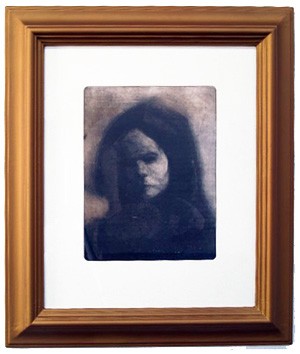 He begins the artist’s talk with his entire biography: “I’m Jason Greig, and I’m 46… I grew up drawing, playing soccer and tennis — an idyllic childhood with a melancholic haze. Very very shy, quite introspective — just found out I’m dyslexic … so, compensated with the visual. My first drawings were chauffeurs with psychedelic hats.” This takes around 45 minutes … and it’s rivetting. Why shouldn’t we meet the artist’s demons?
He begins the artist’s talk with his entire biography: “I’m Jason Greig, and I’m 46… I grew up drawing, playing soccer and tennis — an idyllic childhood with a melancholic haze. Very very shy, quite introspective — just found out I’m dyslexic … so, compensated with the visual. My first drawings were chauffeurs with psychedelic hats.” This takes around 45 minutes … and it’s rivetting. Why shouldn’t we meet the artist’s demons?
Greig was very generous, to a fault, in answering questions and revealed as many trade secrets as we were willing to ask for. He is a no bullshit, total rock and roll guy, and his work is genuine and marvelous. See more of it here.
Right, above: Jason Greig, The Devil had a daughter, 2006, monoprint, 1/1, 77 x 67cm
+ + +
Workers after hours. August 18. An office party to celebrate a colleague’s serious birthday. “Workplace culture” — the phrase is clumsy but useful — it really is where we suck up a good deal of our life is sucked up. And so often it’s a drag. Makes one think of the great crowds — John Brack — swilling at city pubs after work at five and before they closed at six. The relief. And the tumble back into the trains and trams for home as the staff hose out the tiles.
+ + +
Ballarat in the picture. August 21. Up to Ballarat for the International Foto Biennale. A couple of friends are showing, and it’s a comprehensive survey of a certain kind of photography — it’s surprising how conservative so much photography is, with strong roots in tradition. Not that I’m complaining, but the more wayward and recherché the rest of contemporary art becomes, the more grounded photography seems, even with every opportunity to photoshop.
The exhibits are spread around town; one I find curiously satisfying is right in the Art Gallery, by a couple called Louvíere + Vanessa from the US. They have a handmade aesthetic and their large thin prints are stained with, among other stuff, blood. It’s not in the link above, but there are some rather amazing, disturbing images of “dogs”, or something doggish. The ancient father-in-law looked at me with raised eyebrows, exclaiming, ‘Most unusual!’
It’s a big Biennale so I must return to see some more, but the most provocative exhibit that day was Love At First Sight by Konrad Winkler, which is (appropriately?) housed way out — maybe 10 mins drive — at Buninyong Brewery. The invitation card with its coyly unsettling frontal shot of a panty-clad crotch advises: “Please note this exhibition contains adult content and is not recommended for children.” That’s because Konrad, a friend, is showing 20 smallish black and white prints about the love story, the relationship, between himself and his wife as manifested in their body parts — faces, knees, stomach, hands, hair, genitals — in the peripheral moments around the act of sex. (Both artist and wife have posted brief notes on the wall — the photos are shown propped in rows on two trestle tables. One recalls that it is the wife’s hometown… mmm. I did ask the artist’s wife’s mother who was there with her Zimmer frame what she thought of the show. Leila is 90; she said firmly, ‘Oh it’s excellent!’)
The pictures of the genitals have an unsensational intimacy; the facial expressions, especially those of Roz, his wife, are nothing short of remarkable, and beautiful. It is the opposite of Mapplethorpe with his careful theatre and objectifications — this feels like The Real. Some respectable art institution should immediately snap up a set — if photography’s documentation can propose an unique kind of truthtelling, these photos are a gently profound example of what it’s good for.
+ + +
28 days later, stop the clocks. (Pause.) Start the clocks.

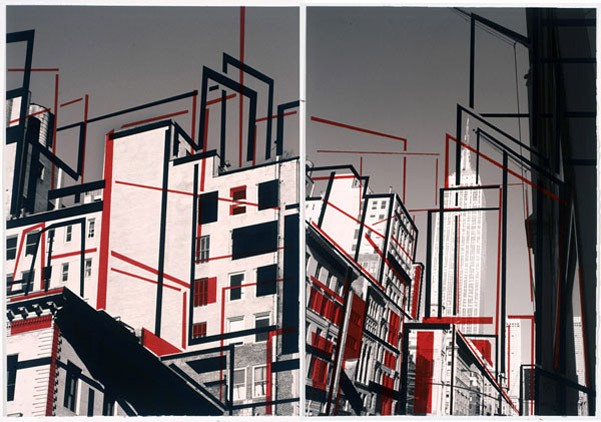
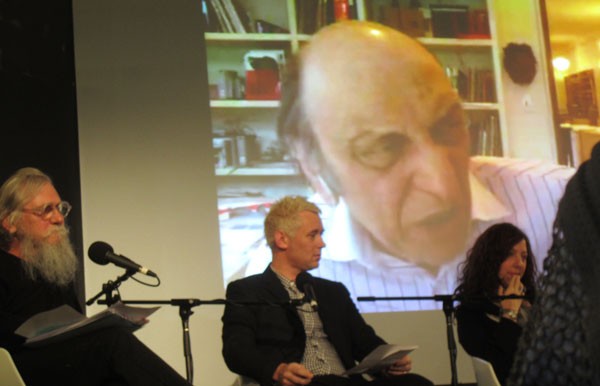
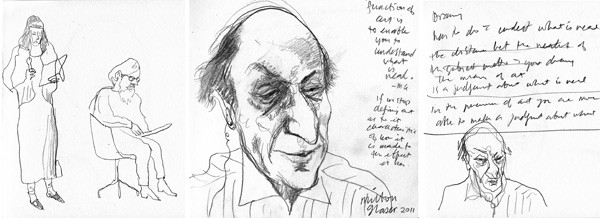
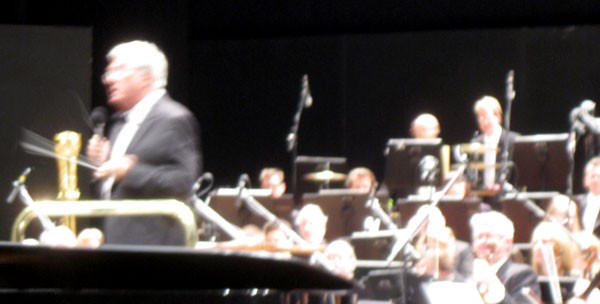
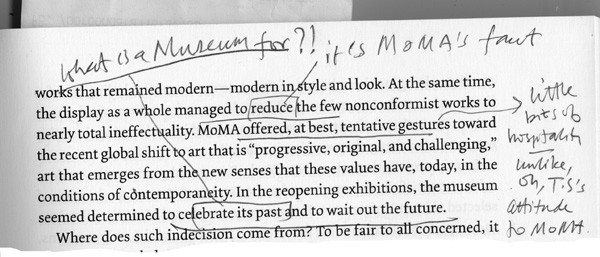
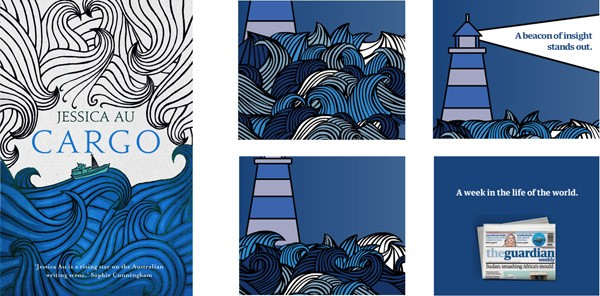


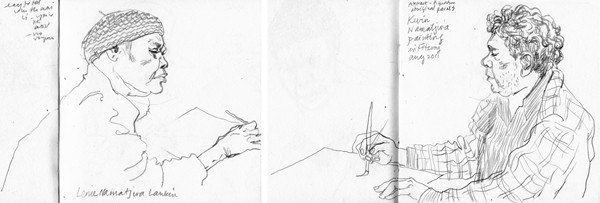







Crikey is committed to hosting lively discussions. Help us keep the conversation useful, interesting and welcoming. We aim to publish comments quickly in the interest of promoting robust conversation, but we’re a small team and we deploy filters to protect against legal risk. Occasionally your comment may be held up while we review, but we’re working as fast as we can to keep the conversation rolling.
The Crikey comment section is members-only content. Please subscribe to leave a comment.
The Crikey comment section is members-only content. Please login to leave a comment.